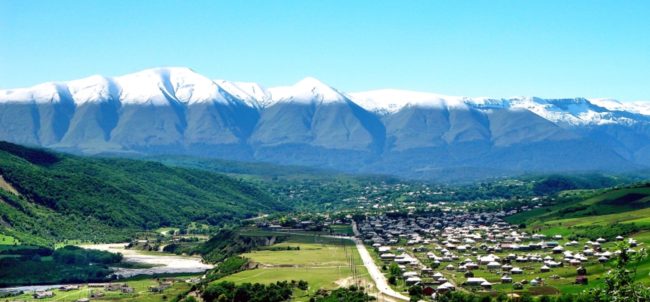Daghestani head promises to restore historic Aukh District amidst rising tensions between Chechens and Avars


 The head of Daghestan, Ramazan Abdulatipov, has pledged that the government will support the restoration of the historic Aukh District, but in a truncated form. Abdulatipov made the announcement during a visit to Daghestan’s Kazbekovsky and Novolaksky districts — territories of the former Aukh District which were repopulated with ethnic Avars and Laks after the deportation of Chechens in 1944.
The head of Daghestan, Ramazan Abdulatipov, has pledged that the government will support the restoration of the historic Aukh District, but in a truncated form. Abdulatipov made the announcement during a visit to Daghestan’s Kazbekovsky and Novolaksky districts — territories of the former Aukh District which were repopulated with ethnic Avars and Laks after the deportation of Chechens in 1944.
On 25 June, a fight between two young men broke out in Leninaul, in Kazbekovsky District, after one allegedly pushed the other while walking by. The conflict quickly gained an ethnic nature, as the young men belonged to two different ethnicities — Chechens and Avars — and groups of young men from both ethnic groups soon became involved.
On 7 July, a group of Chechens from Leninaul went to Grozny, according to local residents, to find support. Russian security forces subsequently blocked the entrance to the village to prevent more Chechens from arriving.
When the Speaker of the Chechen Parliament, Magomed Daudov, arrived at the border of the village, someone from the crowd threw stones at his car.
‘It was a pure provocation. Someone began throwing stones at Daudov’s people, who began to shoot into the air. It feels like it was all done to record a video and to provoke a fight’, Abdurakhman, an inhabitant of Leninaul, told OC Media.
On 9 July, Abdulatipov visited both Kazbekovsky and Novolaksky districts, but did not visit the site of the conflict — Leninaul. Instead, he met with local activists in the Kazbekovsky District’s capital of Dylym.
According to Caucasian Knot, Abdulatipov said that he would contribute to the restoration of the Aukh District, but only if it doesn’t include two large villages — Leninaul and Kalininaul — which currently lie in the Kazbekovsky District.
Chechen historian and publicist Mayrbek Vachagayev told OC Media that not including these two villages in a future Aukh District is the main obstacle for restoring it.
‘The decision to restore the Aukh District was made back in 1991. The villages of Leninaul and Kalininaul make up almost one-third of the whole Aukh District. This is a big territory. [Daghestani authorities] say: “At the first stage, let’s do it without these two villages”. This is the reason why the Aukh District hasn’t been restored yet. In this case, one-third of the whole Aukh District will be left out: two-thirds of the population will have their rights restored, and one-third won’t. That’s why this conflict is still going on’, Vachagayev told OC Media.
[OC Media is currently working on an interview with historian and publicist Mayrbek Vachagayev about the situation in the Kazbekovsky District of Daghestan and the restoration of the Aukh District]
The conflict in Leninaul is currently not active, with local residents telling OC Media that there is no more fighting or shooting in the village.
In 1944, the Chechen population of the Aukh District was deported to Central Asia and the district was renamed Novolaksky (‘New-Lak’) and populated with ethnic Laks from other regions of Daghestan. A part of the Aukh District was transferred to the Kazbekovsky District and populated by ethnic Avars. In 1956, the Chechen population began to return from the deportation.
[Read on OC Media: After 73 years, the memory of Stalin’s deportation of Chechens and Ingush still haunts the survivors]
Since the 1980s, local Chechens have been calling for restoration of Aukh District, and relocating the Laks and Avars into other areas of Daghestan. In 1991, the Third Congress of the People’s Deputies of Daghestan decided to restore the Aukh District, but because of a lack of financing for the resettlement of Laks, the restoration of the district was pushed back indefinitely. In 1999, during the Second Chechen War, Novolaksky District was the scene of intense fighting between Chechen and Russian armies.






